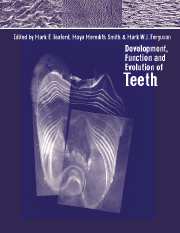Book contents
- Frontmatter
- Contents
- List of contributors
- Acknowledgements
- Part one Genes, molecules and tooth initiation
- Part two Tooth tissues: development and evolution
- Part three Evolution of tooth shape and dentition
- 10 Evolutionary origins of teeth and jaws: developmental models and phylogenetic patterns
- 11 Development and evolution of dentition patterns and their genetic basis
- 12 Evolution of tooth attachment in lower vertebrates to tetrapods
- 13 Tooth replacement patterns in non-mammalian vertebrates
- 14 The evolution of tooth shape and tooth function in primates
- 15 ‘Schultz's Rule’ and the evolution of tooth emergence and replacement patterns in primates and ungulates
- Part four Macrostructure and function
- Index
14 - The evolution of tooth shape and tooth function in primates
Published online by Cambridge University Press: 11 September 2009
- Frontmatter
- Contents
- List of contributors
- Acknowledgements
- Part one Genes, molecules and tooth initiation
- Part two Tooth tissues: development and evolution
- Part three Evolution of tooth shape and dentition
- 10 Evolutionary origins of teeth and jaws: developmental models and phylogenetic patterns
- 11 Development and evolution of dentition patterns and their genetic basis
- 12 Evolution of tooth attachment in lower vertebrates to tetrapods
- 13 Tooth replacement patterns in non-mammalian vertebrates
- 14 The evolution of tooth shape and tooth function in primates
- 15 ‘Schultz's Rule’ and the evolution of tooth emergence and replacement patterns in primates and ungulates
- Part four Macrostructure and function
- Index
Summary
Introduction
Evolution proceeds by selection of phenotypic variations (in this case, of functioning dentitions), and so indirectly of the genotypes that produce them. Evidence for the course of evolution is derived largely from the fossil record, and much of it is provided by teeth. To understand evolution we need to know not only what changes have in fact taken place but also why these changes were of advantage in the functional life of the animal and have thus been selected; in other words, what is the adaptive significance of evolutionary change? In this chapter I will review some of the changes of tooth shape that have taken place in the course of primate evolution, and which appear to be explicable as adaptations to changes of function. Dental adaptations may be considered at two levels. First, there are characters that integrate the teeth into a masticatory system, involving the jaws and their muscles. Then there are modifications of the system in adaptation to functional demands. Most often, these demands are put upon the system by the types of foods eaten, and by feeding behaviour, but for some teeth, especially the incisors and canines, these functions may be unconnected with feeding (for example, grooming and fighting).
Brief introduction to fossil primates
Primates were derived from primitive insectivorous eutherians in the Cretaceous, and I will use one of these, Kennalestes (Kielan-Jaworowska, 1968, 1981), as a basis of comparison to show the direction of evolutionary change. The early palaeontological history of primates has recently been reviewed by Rose (1995) and Rose et al. (1994).
- Type
- Chapter
- Information
- Development, Function and Evolution of Teeth , pp. 201 - 211Publisher: Cambridge University PressPrint publication year: 2000
- 17
- Cited by



